Business in Practice: Tesco's Structures, PESTLE Analysis Report
VerifiedAdded on 2023/01/05
|10
|2480
|63
Report
AI Summary
This report provides a comprehensive analysis of various business structures, including micro, small, medium, and large businesses, as well as sole proprietorships, partnerships, limited liability partnerships, and corporations. It explores how organizational structure impacts business productivity, differentiating between flat and hierarchical structures. The report also delves into the PESTLE analysis, examining the political, economic, social, technological, legal, and environmental factors that influence business performance, using Tesco as a specific example. The analysis covers how these external factors affect the company's operations, market position, and overall success. The report also examines the characteristics of different business structures, organizational structures, and the application of PESTLE analysis to understand external factors affecting business performance.
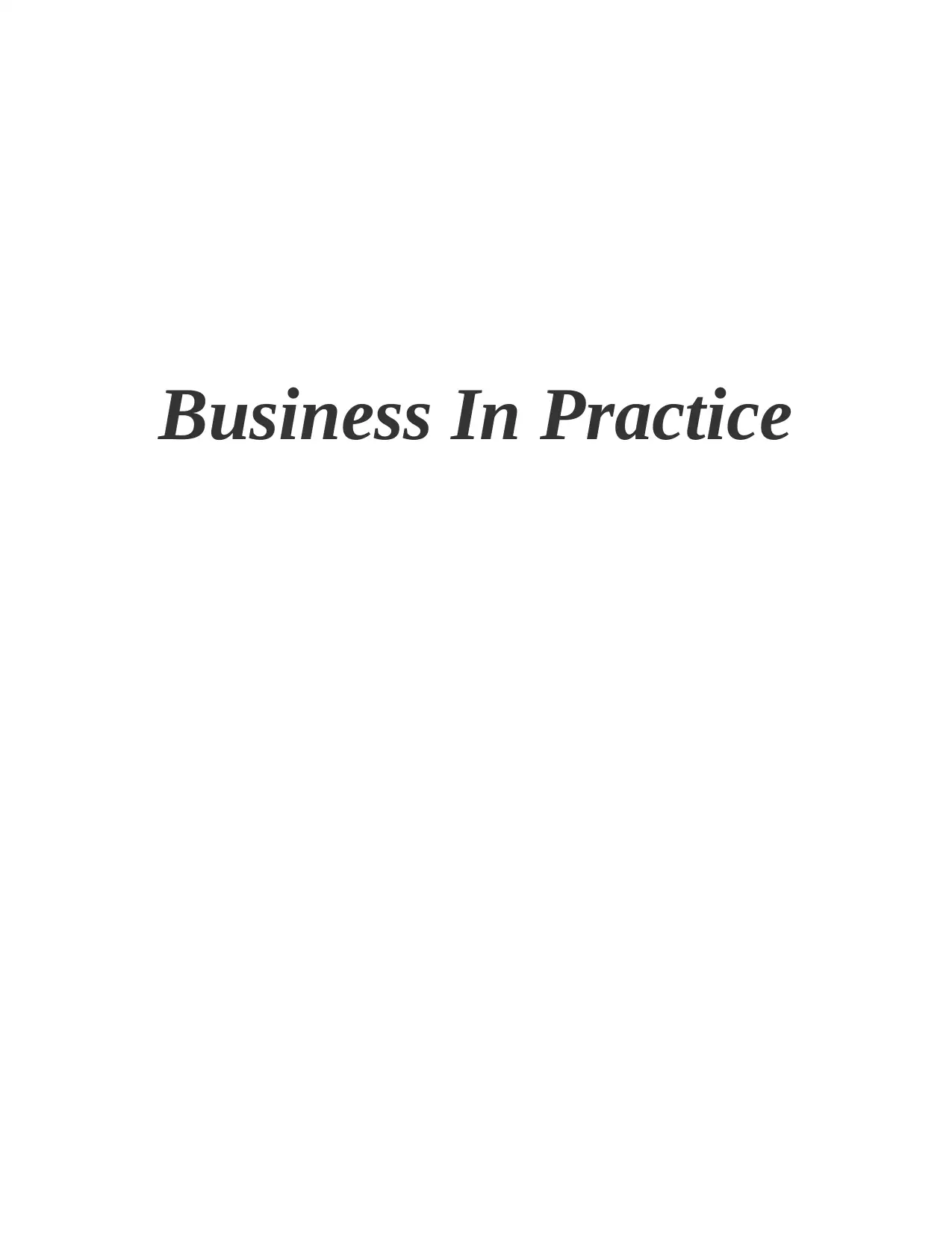
Business In Practice
Paraphrase This Document
Need a fresh take? Get an instant paraphrase of this document with our AI Paraphraser

Table of Contents
INTRODUCTION...........................................................................................................................3
MAIN BODY...................................................................................................................................3
SECTION 1......................................................................................................................................3
Definition, characteristics and example of micro business, small business, medium size
business and large size business.............................................................................................3
SECTION 2......................................................................................................................................4
Definition, characteristics and example of sole trader business, partnership, limited liability
business, public limited liability business and Cooperative...................................................4
SECTION 3......................................................................................................................................7
Identify different organisational structures and explain how organisational structure affects
business productivity..............................................................................................................7
Using PESTLE analysis explain how different external factors affect the performance of a
business...................................................................................................................................8
CONCLUSION................................................................................................................................9
REFERENCES..............................................................................................................................10
INTRODUCTION...........................................................................................................................3
MAIN BODY...................................................................................................................................3
SECTION 1......................................................................................................................................3
Definition, characteristics and example of micro business, small business, medium size
business and large size business.............................................................................................3
SECTION 2......................................................................................................................................4
Definition, characteristics and example of sole trader business, partnership, limited liability
business, public limited liability business and Cooperative...................................................4
SECTION 3......................................................................................................................................7
Identify different organisational structures and explain how organisational structure affects
business productivity..............................................................................................................7
Using PESTLE analysis explain how different external factors affect the performance of a
business...................................................................................................................................8
CONCLUSION................................................................................................................................9
REFERENCES..............................................................................................................................10

INTRODUCTION
Business is defined as an activity of undertaking something to achieve different kind of
objectives within pre-determined time period. There are different kinds of businesses having
different purposes and aims such as private organisation have aim to maximise profit whereas
public organisation has aim to improve standard of living of people by offering them quality
products at lower cost. It is important for these organisation to analyse market environment
which are contingent in nature by using analytical model such as PESTLE. The present
assignment report is based on Tesco which is multinational groceries and merchandise retailer of
UK having headquartered in England, UK. It ranked third in world largest retailer according to
gross revenues. The report discusses Definition, characteristics and example of micro business,
small business, medium size business and large size business along with the explanation of
organisational structure. The report also briefly explains PESTLE Model to analyse market
environment.
MAIN BODY
SECTION 1
Definition, characteristics and example of micro business, small business, medium size business
and large size business
Small and medium-sized enterprises (SMEs) endeavours are organizations that take care of
income, resources or various employees with a certain margin. Each country has its own
significance of what constitutes small and medium-sized enterprises (SMEs). Some sizing
measures must be taken and by chance the sector in which the organization operates is also
evaluated. Despite the small number of small and medium-sized enterprises (SMEs) that play an
important role in the economy. They take over large companies, employ a lot of people and are
often resourceful in nature, helping to create progress.
An organization that has developed beyond the constraints of a medium-sized company and
has at least 250 employees lies under large size organization. This is the essence of a highly
esteemed effort received by the UK's Department of Industrial Enterprise and Regulatory Reform
for real reasons. It is usually from the perspective of large global organizations that appear to be
global.
Business is defined as an activity of undertaking something to achieve different kind of
objectives within pre-determined time period. There are different kinds of businesses having
different purposes and aims such as private organisation have aim to maximise profit whereas
public organisation has aim to improve standard of living of people by offering them quality
products at lower cost. It is important for these organisation to analyse market environment
which are contingent in nature by using analytical model such as PESTLE. The present
assignment report is based on Tesco which is multinational groceries and merchandise retailer of
UK having headquartered in England, UK. It ranked third in world largest retailer according to
gross revenues. The report discusses Definition, characteristics and example of micro business,
small business, medium size business and large size business along with the explanation of
organisational structure. The report also briefly explains PESTLE Model to analyse market
environment.
MAIN BODY
SECTION 1
Definition, characteristics and example of micro business, small business, medium size business
and large size business
Small and medium-sized enterprises (SMEs) endeavours are organizations that take care of
income, resources or various employees with a certain margin. Each country has its own
significance of what constitutes small and medium-sized enterprises (SMEs). Some sizing
measures must be taken and by chance the sector in which the organization operates is also
evaluated. Despite the small number of small and medium-sized enterprises (SMEs) that play an
important role in the economy. They take over large companies, employ a lot of people and are
often resourceful in nature, helping to create progress.
An organization that has developed beyond the constraints of a medium-sized company and
has at least 250 employees lies under large size organization. This is the essence of a highly
esteemed effort received by the UK's Department of Industrial Enterprise and Regulatory Reform
for real reasons. It is usually from the perspective of large global organizations that appear to be
global.
⊘ This is a preview!⊘
Do you want full access?
Subscribe today to unlock all pages.

Trusted by 1+ million students worldwide

More individuals and funds to help with large businesses (larger spending plans, internal
typography, files, and so on); more standards, pay, benefits and ways to improve; more doors
open to success and professional development; bigger and more active tasks; less likelihood of
physical bankruptcy in the event of a significant financial event; bigger / better offices with
access to study rooms and so on
Big new organizations like Google have made real efforts to give people in a big
corporation a "little sense of organization." This may include a richer physical culture - no
connections, more access to imaginative sources, a more non-controversial physical style, or
more open doors to work at home or perform "work-life balance."
Characteristics:
Micro Business Small Business Medium size Large size business
A micro business, by
definition, can only be
found in a limited
area. For example,
these groups do not
tend to have sources
of agreement in
different states or
nations. A large
number of small
organizations operate
from a single office,
point of sale, or
administrative store. It
is even possible to
keep an independent
business legitimately
away from home,
without organizing
offices.
Small groups serve
much smaller land
than larger companies
or private groups.
Smaller groups serve
individual networks,
such as a rural
command refuse shop.
The narrow-minded
sense prevents these
groups from serving
much larger
neighbourhood areas,
developing a past that
would build the size
of an independent
company’s business
and lead it to another
character.
For medium-sized
businesses, the
administration is
usually steep. The
owner has to do
almost everything and
delegates are usually
expected to have a
general duty to not be
error free.
Most very large
Companies analyze
their customer base,
identify specific
customer segments,
and identify the
targeting system for
each segment. This
means that different
clients will see
different pages
depending on their
link to the site.
typography, files, and so on); more standards, pay, benefits and ways to improve; more doors
open to success and professional development; bigger and more active tasks; less likelihood of
physical bankruptcy in the event of a significant financial event; bigger / better offices with
access to study rooms and so on
Big new organizations like Google have made real efforts to give people in a big
corporation a "little sense of organization." This may include a richer physical culture - no
connections, more access to imaginative sources, a more non-controversial physical style, or
more open doors to work at home or perform "work-life balance."
Characteristics:
Micro Business Small Business Medium size Large size business
A micro business, by
definition, can only be
found in a limited
area. For example,
these groups do not
tend to have sources
of agreement in
different states or
nations. A large
number of small
organizations operate
from a single office,
point of sale, or
administrative store. It
is even possible to
keep an independent
business legitimately
away from home,
without organizing
offices.
Small groups serve
much smaller land
than larger companies
or private groups.
Smaller groups serve
individual networks,
such as a rural
command refuse shop.
The narrow-minded
sense prevents these
groups from serving
much larger
neighbourhood areas,
developing a past that
would build the size
of an independent
company’s business
and lead it to another
character.
For medium-sized
businesses, the
administration is
usually steep. The
owner has to do
almost everything and
delegates are usually
expected to have a
general duty to not be
error free.
Most very large
Companies analyze
their customer base,
identify specific
customer segments,
and identify the
targeting system for
each segment. This
means that different
clients will see
different pages
depending on their
link to the site.
Paraphrase This Document
Need a fresh take? Get an instant paraphrase of this document with our AI Paraphraser
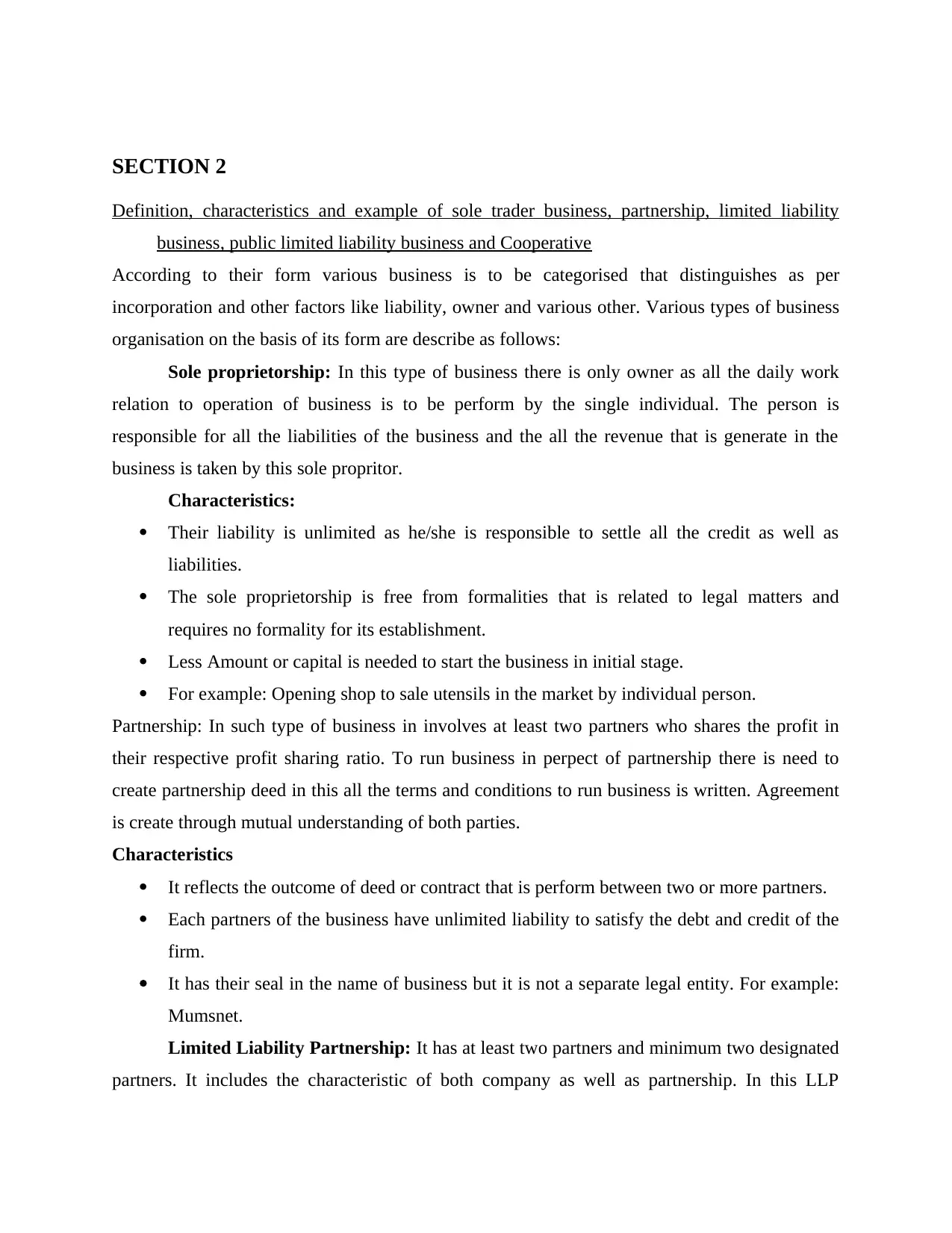
SECTION 2
Definition, characteristics and example of sole trader business, partnership, limited liability
business, public limited liability business and Cooperative
According to their form various business is to be categorised that distinguishes as per
incorporation and other factors like liability, owner and various other. Various types of business
organisation on the basis of its form are describe as follows:
Sole proprietorship: In this type of business there is only owner as all the daily work
relation to operation of business is to be perform by the single individual. The person is
responsible for all the liabilities of the business and the all the revenue that is generate in the
business is taken by this sole propritor.
Characteristics:
Their liability is unlimited as he/she is responsible to settle all the credit as well as
liabilities.
The sole proprietorship is free from formalities that is related to legal matters and
requires no formality for its establishment.
Less Amount or capital is needed to start the business in initial stage.
For example: Opening shop to sale utensils in the market by individual person.
Partnership: In such type of business in involves at least two partners who shares the profit in
their respective profit sharing ratio. To run business in perpect of partnership there is need to
create partnership deed in this all the terms and conditions to run business is written. Agreement
is create through mutual understanding of both parties.
Characteristics
It reflects the outcome of deed or contract that is perform between two or more partners.
Each partners of the business have unlimited liability to satisfy the debt and credit of the
firm.
It has their seal in the name of business but it is not a separate legal entity. For example:
Mumsnet.
Limited Liability Partnership: It has at least two partners and minimum two designated
partners. It includes the characteristic of both company as well as partnership. In this LLP
Definition, characteristics and example of sole trader business, partnership, limited liability
business, public limited liability business and Cooperative
According to their form various business is to be categorised that distinguishes as per
incorporation and other factors like liability, owner and various other. Various types of business
organisation on the basis of its form are describe as follows:
Sole proprietorship: In this type of business there is only owner as all the daily work
relation to operation of business is to be perform by the single individual. The person is
responsible for all the liabilities of the business and the all the revenue that is generate in the
business is taken by this sole propritor.
Characteristics:
Their liability is unlimited as he/she is responsible to settle all the credit as well as
liabilities.
The sole proprietorship is free from formalities that is related to legal matters and
requires no formality for its establishment.
Less Amount or capital is needed to start the business in initial stage.
For example: Opening shop to sale utensils in the market by individual person.
Partnership: In such type of business in involves at least two partners who shares the profit in
their respective profit sharing ratio. To run business in perpect of partnership there is need to
create partnership deed in this all the terms and conditions to run business is written. Agreement
is create through mutual understanding of both parties.
Characteristics
It reflects the outcome of deed or contract that is perform between two or more partners.
Each partners of the business have unlimited liability to satisfy the debt and credit of the
firm.
It has their seal in the name of business but it is not a separate legal entity. For example:
Mumsnet.
Limited Liability Partnership: It has at least two partners and minimum two designated
partners. It includes the characteristic of both company as well as partnership. In this LLP

agreement is prepare. It involves limited liability, the partners are liable to satisfy the liability of
creditors at the time of winding up. It is generally incorporated by the professionals and includes
liability only up to the shares.
Characteristics
It includes limited liability of the parters as per their respective contribution.
It is the combination of both partnership as well as company.
In the agreement is knows as deed that was prepare on the basis of mutual
understanding between all the partners and designated partners.
It has separate and transparent system of tax. As their respective designated
partner as well as partner are responsible to pay tax and it is not the responsibility
of firm and it is not liable to pay tax.
For example: Law firms
Company
Such type of business is incorporate at the companies house. It has its common seal. It is a
separate legal entity different from its owner As it is a artificial personality. The company is
governed and structured as per Companies Act of UK.
There are two type of companies public as well as private , the public company includes
invitation to public for purchasing the shares to become the owner of company as they are known
as shareholders. Example Tesco it is a private company that do not require share purchase but
needs only owners who are called the directors and they can not eligible to raise share capital.
Further it is also classified on the basis of limited and unlimited liability. Thus the limited
company includes limited liability of the owner whose liability are upto extend of their shares in
the business and unlimited company posses unlimited liability.
Characteristics
It has its Memorandum & Articles.
Separate legal entity
It has common seal
Corporative: These are voluntary associations whose main objective is to serve social service
rather than profit motive. These involves members who manage the business and are also the
owners of the cooperative.
Characteristic
creditors at the time of winding up. It is generally incorporated by the professionals and includes
liability only up to the shares.
Characteristics
It includes limited liability of the parters as per their respective contribution.
It is the combination of both partnership as well as company.
In the agreement is knows as deed that was prepare on the basis of mutual
understanding between all the partners and designated partners.
It has separate and transparent system of tax. As their respective designated
partner as well as partner are responsible to pay tax and it is not the responsibility
of firm and it is not liable to pay tax.
For example: Law firms
Company
Such type of business is incorporate at the companies house. It has its common seal. It is a
separate legal entity different from its owner As it is a artificial personality. The company is
governed and structured as per Companies Act of UK.
There are two type of companies public as well as private , the public company includes
invitation to public for purchasing the shares to become the owner of company as they are known
as shareholders. Example Tesco it is a private company that do not require share purchase but
needs only owners who are called the directors and they can not eligible to raise share capital.
Further it is also classified on the basis of limited and unlimited liability. Thus the limited
company includes limited liability of the owner whose liability are upto extend of their shares in
the business and unlimited company posses unlimited liability.
Characteristics
It has its Memorandum & Articles.
Separate legal entity
It has common seal
Corporative: These are voluntary associations whose main objective is to serve social service
rather than profit motive. These involves members who manage the business and are also the
owners of the cooperative.
Characteristic
⊘ This is a preview!⊘
Do you want full access?
Subscribe today to unlock all pages.

Trusted by 1+ million students worldwide
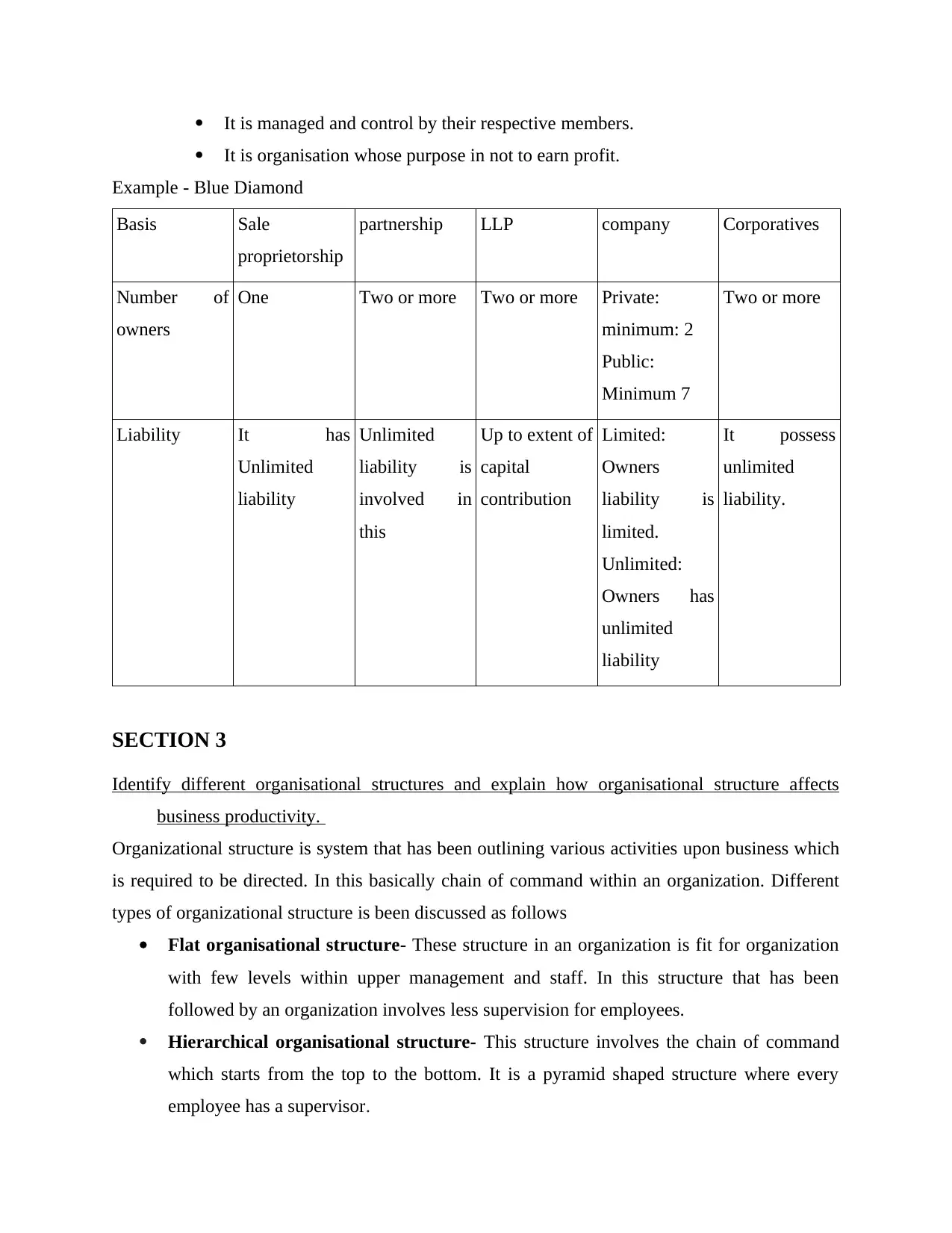
It is managed and control by their respective members.
It is organisation whose purpose in not to earn profit.
Example - Blue Diamond
Basis Sale
proprietorship
partnership LLP company Corporatives
Number of
owners
One Two or more Two or more Private:
minimum: 2
Public:
Minimum 7
Two or more
Liability It has
Unlimited
liability
Unlimited
liability is
involved in
this
Up to extent of
capital
contribution
Limited:
Owners
liability is
limited.
Unlimited:
Owners has
unlimited
liability
It possess
unlimited
liability.
SECTION 3
Identify different organisational structures and explain how organisational structure affects
business productivity.
Organizational structure is system that has been outlining various activities upon business which
is required to be directed. In this basically chain of command within an organization. Different
types of organizational structure is been discussed as follows
Flat organisational structure- These structure in an organization is fit for organization
with few levels within upper management and staff. In this structure that has been
followed by an organization involves less supervision for employees.
Hierarchical organisational structure- This structure involves the chain of command
which starts from the top to the bottom. It is a pyramid shaped structure where every
employee has a supervisor.
It is organisation whose purpose in not to earn profit.
Example - Blue Diamond
Basis Sale
proprietorship
partnership LLP company Corporatives
Number of
owners
One Two or more Two or more Private:
minimum: 2
Public:
Minimum 7
Two or more
Liability It has
Unlimited
liability
Unlimited
liability is
involved in
this
Up to extent of
capital
contribution
Limited:
Owners
liability is
limited.
Unlimited:
Owners has
unlimited
liability
It possess
unlimited
liability.
SECTION 3
Identify different organisational structures and explain how organisational structure affects
business productivity.
Organizational structure is system that has been outlining various activities upon business which
is required to be directed. In this basically chain of command within an organization. Different
types of organizational structure is been discussed as follows
Flat organisational structure- These structure in an organization is fit for organization
with few levels within upper management and staff. In this structure that has been
followed by an organization involves less supervision for employees.
Hierarchical organisational structure- This structure involves the chain of command
which starts from the top to the bottom. It is a pyramid shaped structure where every
employee has a supervisor.
Paraphrase This Document
Need a fresh take? Get an instant paraphrase of this document with our AI Paraphraser

Marks & Spencer is required to follow organizational structure in which limited level of
management within administration department and front line staff. Structure to be followed by
ban organization within decision making should be encouraged by organization.
Basis Hierarchical Flat
Level of management In this ranges from low to high
level is involved at various levels
of management.
In this least level of management is
involved.
Suitability It is required upon large
organizations.
In this suitable small organizations
is been compared over those
organization through which decision
making is done by employees.
Supervision Every employee has a supervisor. Less supervision is involved.
Using PESTLE analysis explain how different external factors affect the performance of a
business.
PESTEL analysis is that kind of tools that has been used for oversee various affect up[on
impact through external factors that impacts working of organization. PESTEL analysis is done
upon Marks & Spencer that has been explained as follows:
Political- This factor is based upon working of M&S within an organization as it is an
global brand which makes establishment possible over different locations. The
organization is been benefited of EC's trade agreement. This can make travel its product
without restriction in different countries. The company has full support from the
government which gives benefit in its working and performance.
Economic- In this various factors are being included like inflation, foreign exchange
rates, etc. As per this rise in inflation makes impact over working in an organization like
M&S which decreases profits. Organization deals within high quality products that has
decreased its profit in negative manner. Organization is dealing with high quality
products which decreases demand that give rise to inflation.
Social- In this factor cultural factors is included that includes customer trends, market
trends etc. Organization like M&S dealing with high products which keep changes in
management within administration department and front line staff. Structure to be followed by
ban organization within decision making should be encouraged by organization.
Basis Hierarchical Flat
Level of management In this ranges from low to high
level is involved at various levels
of management.
In this least level of management is
involved.
Suitability It is required upon large
organizations.
In this suitable small organizations
is been compared over those
organization through which decision
making is done by employees.
Supervision Every employee has a supervisor. Less supervision is involved.
Using PESTLE analysis explain how different external factors affect the performance of a
business.
PESTEL analysis is that kind of tools that has been used for oversee various affect up[on
impact through external factors that impacts working of organization. PESTEL analysis is done
upon Marks & Spencer that has been explained as follows:
Political- This factor is based upon working of M&S within an organization as it is an
global brand which makes establishment possible over different locations. The
organization is been benefited of EC's trade agreement. This can make travel its product
without restriction in different countries. The company has full support from the
government which gives benefit in its working and performance.
Economic- In this various factors are being included like inflation, foreign exchange
rates, etc. As per this rise in inflation makes impact over working in an organization like
M&S which decreases profits. Organization deals within high quality products that has
decreased its profit in negative manner. Organization is dealing with high quality
products which decreases demand that give rise to inflation.
Social- In this factor cultural factors is included that includes customer trends, market
trends etc. Organization like M&S dealing with high products which keep changes in
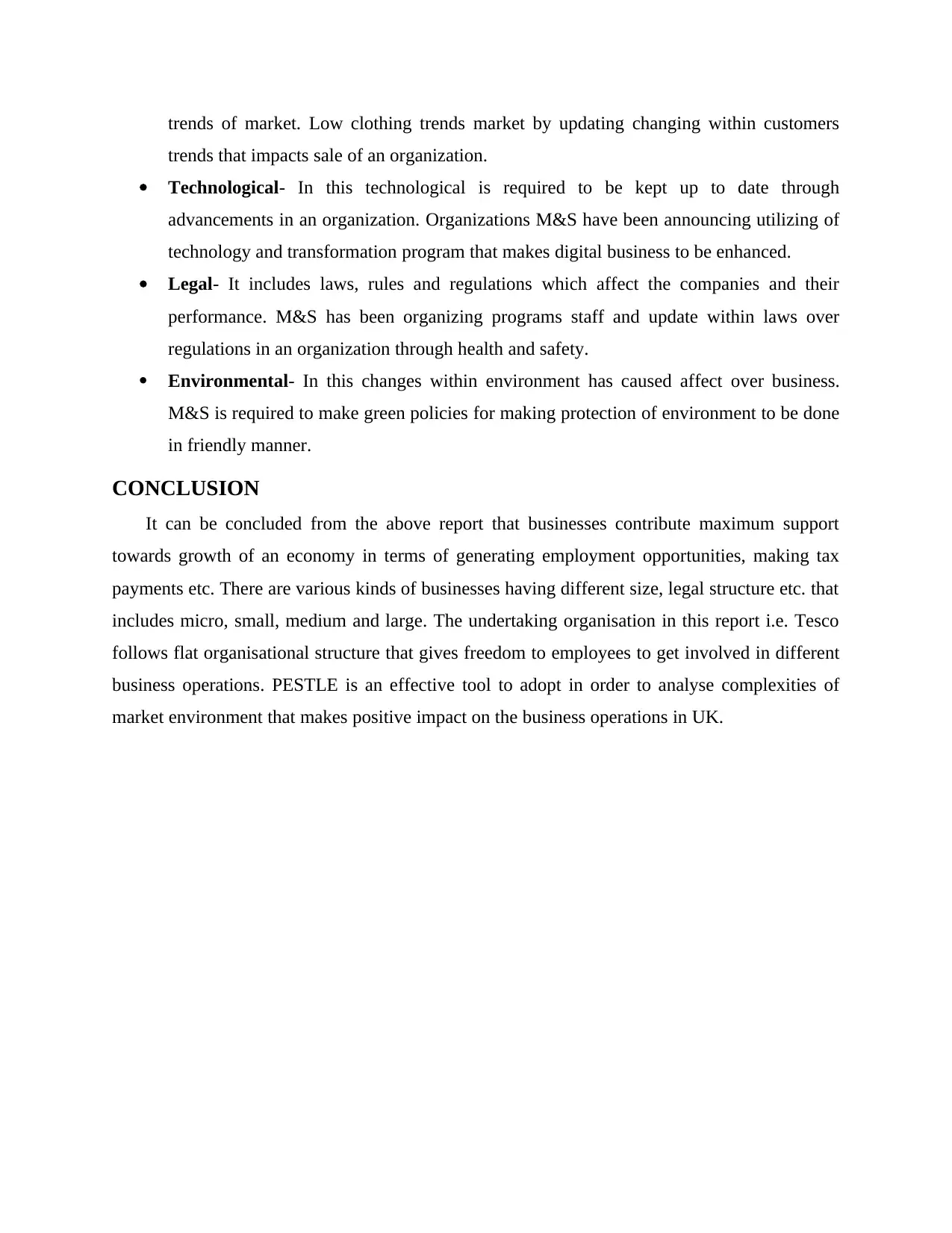
trends of market. Low clothing trends market by updating changing within customers
trends that impacts sale of an organization.
Technological- In this technological is required to be kept up to date through
advancements in an organization. Organizations M&S have been announcing utilizing of
technology and transformation program that makes digital business to be enhanced.
Legal- It includes laws, rules and regulations which affect the companies and their
performance. M&S has been organizing programs staff and update within laws over
regulations in an organization through health and safety.
Environmental- In this changes within environment has caused affect over business.
M&S is required to make green policies for making protection of environment to be done
in friendly manner.
CONCLUSION
It can be concluded from the above report that businesses contribute maximum support
towards growth of an economy in terms of generating employment opportunities, making tax
payments etc. There are various kinds of businesses having different size, legal structure etc. that
includes micro, small, medium and large. The undertaking organisation in this report i.e. Tesco
follows flat organisational structure that gives freedom to employees to get involved in different
business operations. PESTLE is an effective tool to adopt in order to analyse complexities of
market environment that makes positive impact on the business operations in UK.
trends that impacts sale of an organization.
Technological- In this technological is required to be kept up to date through
advancements in an organization. Organizations M&S have been announcing utilizing of
technology and transformation program that makes digital business to be enhanced.
Legal- It includes laws, rules and regulations which affect the companies and their
performance. M&S has been organizing programs staff and update within laws over
regulations in an organization through health and safety.
Environmental- In this changes within environment has caused affect over business.
M&S is required to make green policies for making protection of environment to be done
in friendly manner.
CONCLUSION
It can be concluded from the above report that businesses contribute maximum support
towards growth of an economy in terms of generating employment opportunities, making tax
payments etc. There are various kinds of businesses having different size, legal structure etc. that
includes micro, small, medium and large. The undertaking organisation in this report i.e. Tesco
follows flat organisational structure that gives freedom to employees to get involved in different
business operations. PESTLE is an effective tool to adopt in order to analyse complexities of
market environment that makes positive impact on the business operations in UK.
⊘ This is a preview!⊘
Do you want full access?
Subscribe today to unlock all pages.

Trusted by 1+ million students worldwide
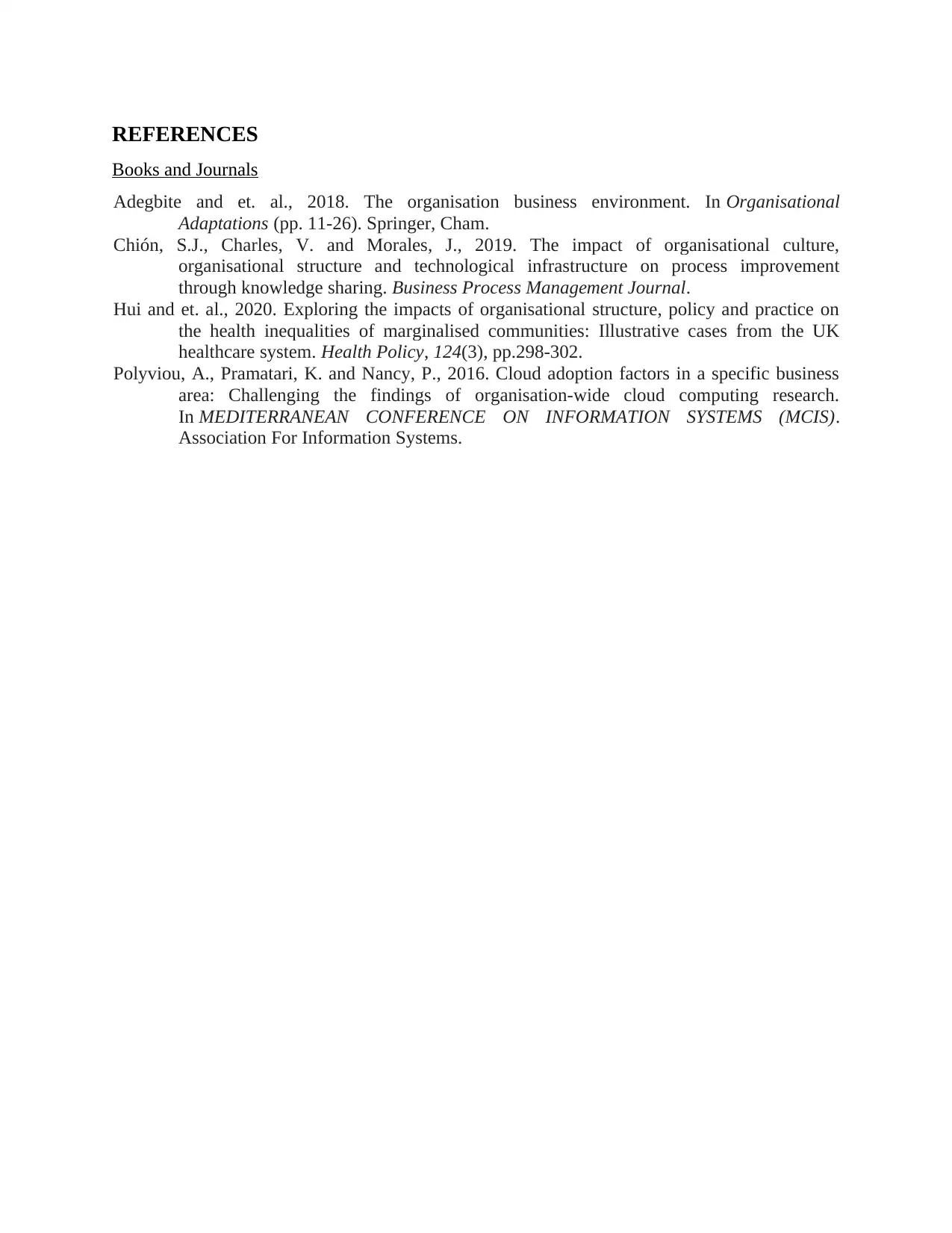
REFERENCES
Books and Journals
Adegbite and et. al., 2018. The organisation business environment. In Organisational
Adaptations (pp. 11-26). Springer, Cham.
Chión, S.J., Charles, V. and Morales, J., 2019. The impact of organisational culture,
organisational structure and technological infrastructure on process improvement
through knowledge sharing. Business Process Management Journal.
Hui and et. al., 2020. Exploring the impacts of organisational structure, policy and practice on
the health inequalities of marginalised communities: Illustrative cases from the UK
healthcare system. Health Policy, 124(3), pp.298-302.
Polyviou, A., Pramatari, K. and Nancy, P., 2016. Cloud adoption factors in a specific business
area: Challenging the findings of organisation-wide cloud computing research.
In MEDITERRANEAN CONFERENCE ON INFORMATION SYSTEMS (MCIS).
Association For Information Systems.
Books and Journals
Adegbite and et. al., 2018. The organisation business environment. In Organisational
Adaptations (pp. 11-26). Springer, Cham.
Chión, S.J., Charles, V. and Morales, J., 2019. The impact of organisational culture,
organisational structure and technological infrastructure on process improvement
through knowledge sharing. Business Process Management Journal.
Hui and et. al., 2020. Exploring the impacts of organisational structure, policy and practice on
the health inequalities of marginalised communities: Illustrative cases from the UK
healthcare system. Health Policy, 124(3), pp.298-302.
Polyviou, A., Pramatari, K. and Nancy, P., 2016. Cloud adoption factors in a specific business
area: Challenging the findings of organisation-wide cloud computing research.
In MEDITERRANEAN CONFERENCE ON INFORMATION SYSTEMS (MCIS).
Association For Information Systems.
1 out of 10
Related Documents
Your All-in-One AI-Powered Toolkit for Academic Success.
+13062052269
info@desklib.com
Available 24*7 on WhatsApp / Email
![[object Object]](/_next/static/media/star-bottom.7253800d.svg)
Unlock your academic potential
Copyright © 2020–2025 A2Z Services. All Rights Reserved. Developed and managed by ZUCOL.




